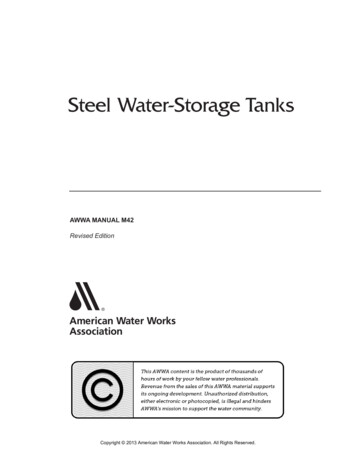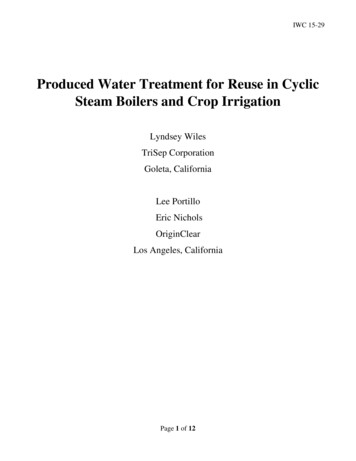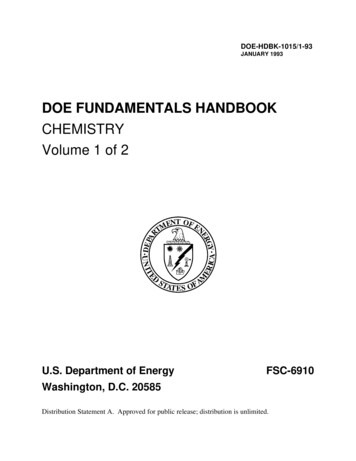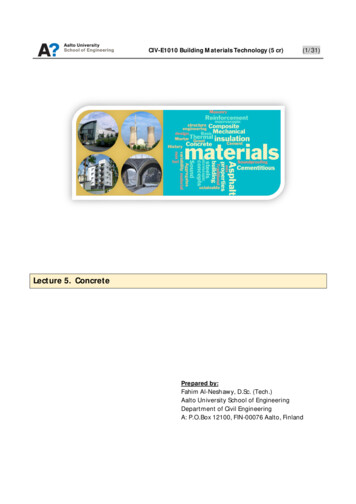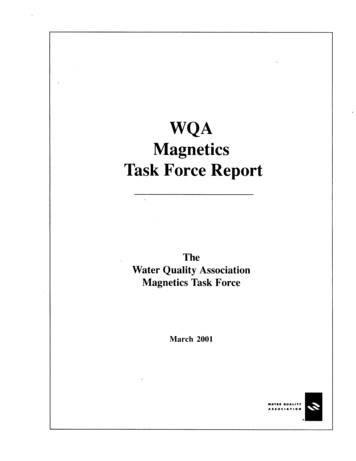
Transcription
The Water Quality AssociationThe Water Quality Association (WQA) is the not-for-profit trade association representingthe household, commercial, light industrial, and small system water treatment industry.WQA’s primary objectives are to: Ensure fairness in legislative, regulatory, and media coverage of the industry,Foster dedication to integrity by expanding education opportunities, enhancingtechnical expertise, substantiation of product performances, and ethical standards inresponsible marketing and advertising, andBroaden acceptance of the industry through consumer confidence and trust in watertreatment products and services.THE WATER QUALITY ASSOCIATION4151 Naperville RoadLisle, Illinois 60532-1088Phone: 630 505 0160Fax: 630 505 9637Web site Address: www.wqa.orgi
TABLE OF CONTENTS1. Preface.12. Introduction.23. Summaries of 34 Scientific Papers .34. Discussion . 275. Conclusion . 306. Bibliography . 32ii
PREFACEThe content of the following report has been prepared by a special task force establishedby the Water Quality Association and represents the review by the members of the taskforce of a bibliography of scientific papers and information generally available to thepublic or released by the authors themselves. The views of the individual members of thetask force, as well as their collective views contained in the text of the report andsummaries herein, are intended solely as an aid, among others, in understanding the stateof scientific research in the field of the possible effects of magnetic devices in thetreatment of water. WQA recognizes that the development of science in this area is in itsrelative infancy and that much additional research is required for a fuller, more completeunderstanding of the relevant science. It, therefore, encourages readers of this report toconduct their own review of the entire body of scientific literature, including all originalsource materials, and to conduct or have conducted their own independent research beforeforming opinions or drawing conclusions regarding the efficacy of any affectedtechnology, process, or device.Although WQA strives to provide accurate, timely, and authoritative information, it cannotwarrant the content or conclusions of this report, nor can it be responsible for inaccuratestatements, errors, or omissions either with respect to the accuracy of the content herein orof the underlying source information reviewed. The content contributed by individualmembers of the task force represents their opinions, findings, and conclusions based upontheir knowledge and experience in the discipline of the scientific method, and theircontribution, as with the subject matter of the entire report, is limited strictly to a review ofthe science against that discipline and methodology. This report is not a substantivereview of or opinion regarding the ultimate validity of the underlying science as applied toany technology, process, or device and should not be represented as such. The report issolely for educational and background information purposes and is presented in theacademic spirit of free, open, and uncensored debate and exchange on scientific matters.As such, this report must not be used out of context and may not be cited, quoted,referenced, or used by anyone except in its entirety, which must include this disclaimer,without the prior express written permission of WQA.Copyright 2001 Water Quality Association. All Rights Reserved. Printed in the UnitedStates of America. No part of this publication may be reproduced, stored in a retrievalsystem or transmitted, in any form or by means, electronic, mechanical, photocopying,recording or otherwise, without the prior written permission of WQA. Any reproductionor redistribution of this report in whole or in part is expressly prohibited by law, and mayresult in severe civil and criminal penalties.1
WQA Magnetics Task Force ReportMarch 2001In February 1999, the Water Quality Association established a special task force of scientists toreview the scientific literature underlying the use of magnetic water treatment devices.Following are the members of the Magnetics Task Force: Daniel T. Carty, Ph.D., Brita ProductsCo. (The)/Clorox Serv. Co.; Professor Young I. Cho, Ph.D., Department of MechanicalEngineering and Mechanics, Drexel University; Joseph A. Cotruvo, Ph.D., NSF International(formerly Director of Drinking Water Standards, U.S. Environmental Protection Agency);Robert V. Herman, CWS-I, Drinking Water Treatment Unit Program, NSF International;Raymond G. Jaglowski, Ph.D., Access Business Group, Amway Corporation; Joseph L. Katz,Ph.D., Department of Chemical Engineering, Johns Hopkins University; Professor WolfgangKuhn, Ph.D., and Ivo Wagner, Ph.D., DVGW, Germany; Kent W. Smothers, Illinois State WaterSurvey; and Joseph F. Harrison, P.E., CWS-VI, Water Quality Association. Dr. Carty served aschair of the task force.The task force established a single objective -- to identify, through a bibliographic format, thepublished, but not proprietary and not anecdotal, scientific studies and papers that the task forcemembers judge to have followed sound scientific method in the field of magnetic and physicalwater treatment. The task force agreed not to review or include in the working bibliographynarrative reports and conclusions which may not be rigorously objective and scientifically valid.Most importantly, the task force’s charter was not to express views on the relative or ultimatemerits of the underlying science or to reach any conclusion on efficacy, but simply to provide acompendium and comprehensive review of available scientific papers written on the subject ofmagnetic water treatment technology and to make recommendations to WQA on possible nextsteps.The task force has completed its bibliographical reviews against the scientific method and theprocess of reaching consensus on 106 papers identified through a literature search on magneticwater treatment. This study, the review of papers, and the task force’s conclusions also coverother physical water conditioning methods, such as electronic, electrolytic, electromagnetic,catalytic, and radio frequency devices, as well as the magnetic technologies. Consensus has beenreached that thirty-four of these papers represent studies meeting the criteria for demonstratingscientifically valid analytical procedures, including the collection of measurable quantitative datathrough observation and experiment, formulation of hypotheses, and the testing and confirmationof the hypotheses formulated. These thirty-four accepted papers are summarized in the text ofthis report. The remaining papers, which themselves may provide helpful information, insights,data, and areas of further inquiry, are included along with the summarized papers in the workingbibliography following the report.2
Magnetic Treatment of Fluids(no date)Paper #20Author: Donaldson, J. D.This was a presentation at a symposium organized in the United Kingdom by HDL FluidDynamics, a magnetic device manufacturer. Article starts out in a favorable tone right away. Refers to few very positive field demonstrations first. Reports on “laboratory” studies. Experimental procedures not clearly spelled out. Reports results showing changes in particle size, crystallinity, crystal morphology,crystal phase, solubility, and rate of precipitation. Changes in crystal morphology is shown by studying the x-ray diffraction of particlessubjected to magnetic treatment for 30, 40, and 150 minutes. Solubility of Ca3(PO4)2 is reported to be affected significantly by magnetic treatmentapplied for 24 and 120 hours. Rest of the changes reported are not based on numbers, but words.Performance Analysis of Permanent Magnet Type Water Treatment Devices(1981)Paper #29Authors: Gruber, Carl E.Carda, Dan D.This is a straightforward performance test of: Class I (clamps on to the outside of a pipe and produces a longitudinalmagnetic field). Class III (radial with annular flow tube consisting of a series of alternately poledcylindrical magnets along the axis of the unit). water softener against no treatment.Water(s) coming out were heated to 62 C in separate heaters and: flow was during four, ten-minute periods within 24 hours. total volume per day was 70 gallons through each heater. test period was July 6 through August 27.3
Results:UnitSoftenerClass IIIRawClass IWeight Loss atAnode16.9 g5.0 g6.2 g5.6 gScale on Heaters0.5 g6.3 g4.5 g3.4 gScale onTemperature Sensor0.00.7 0.1 g0.4 0.1 g0.2 0.1 gOther measurements included boiling point depression, surface tension, water conductivity, and“scaling rate”. There was no difference noted between raw and the two magnets.Based on all of these and appearance of scale in the tanks, heating rods, sensor, etc., the paperconcludes that there is no measurable effect in these circumstances resulting from the selectedmagnetic devices.A Revue of Scale Formation and Scale Prevention, with Emphasis onMagnetic Water Treatment(1983)Paper #24Author: Ellingsen, FrankThis is from a person employed by a magnetic water treatment device (POLAR) manufacturer inNorway. Initial discussion of scale formation and scale prevention is technically good.Gives a definition of nonchemical water treatment as “A method based on mechanical (e.g.vibration), electrical, or magnetic principles.” (May be useful later for discussing protocolcommon for physical or nonchemical devices).Has done laboratory work. But not clearly explained as to what was done. Very confusing.Used different magnetic strength treatment to a naturally hard water raised to pH levels nine orhigher by hydroxides. Shows in one graph, the higher the magnetic strength, the lower will be the pH afterabout 20 minutes. But also claims that the magnet accelerates the rate ofprecipitation. Talks about turning point with zeta potential at zero at that point. But, pH is veryhigh.In another example, water flows through what is called a crystal growth cell. Shows photos withlarger crystals in magnetic treated waters.Not clear as to what the hypothesis is. In one test, higher precipitation due to magnets. Inanother, less crystals due to magnets. It is not clear as to what is concluded in the conclusionsection. This paper is not entirely useful for water treatment assessment.4
Research Reports: Quantitative Assessment of the Effectiveness of PermanentMagnetic Water Conditioning Devices(1985)Paper #1Author: Alleman, James E.Six unidentified magnetic water conditioner devices were tested compared to untreated hardwater each followed by their own water heaters equipped with coupons of different kinds.Testing lasted 240 days of operation. Both water quality parameters and scaling on couponswere monitored during the study.No beneficial effect was seen for the magnetic treatment process.One of the six units yielded higher scaling conditions. No explanation was given as to why.Type of units tested were:1.Exterior mounted circumferential2.In line mounted circumferential3.In line mounted axial4.In line mounted axial and circumferentialEffectiveness of Magnetic Water Treatment in Suppressing CaCO3 ScaleDeposition/The Performance of a Magnetic Water Conditioner underAccelerated Scaling Conditions(1985)Papers 31 & 32Authors: Hasson, DavidBramson, DanThese two papers are actually from the same work. One magnetic device (orthogonal unit – Class II) was tested in the laboratory underthe following conditions: pH – 9.0, 9.5 – 9.7, 10.2 Ca : 200 - 250 ppm, Mg : 165 -175 ppm, Alk: 300 -340 ppm, TDS: 800 - 900 ppm. pH adjustment with NaOH to 9.0 and higher. In all but one test, sodium sulfite was added at high levels of 150 - 300 ppm toprevent the effect of rust contamination, which in their opinion will have an effect ofscale tenacity. Magnetic unit was preceded and followed by test segments. Segments prior tomagnetic were before treatment for comparison with the segments afterward. Flow rate 2 m/s or 15gpm through 1 inch diameter pipe. Test temperature - 19 to 23 C5
Conclusions No magnetic effect evident. Precipitation rate is dependent on pH. Same as before and after magnetic test. In one test, recycling through magnet did not yield any favorable result.Comment Good study except for the addition of the sulfites.Studies of a Water Treatment Device that Uses Magnetic Fields(1986)Paper # 5Author: Busch, K. W.Busch, M. A.Darling, R. E.McAtee, J. L., Jr.Parker, D. H. Appears to be a good laboratory effort.Tested one orthogonal magnetic treatment device (MTD) (different variations) in alaboratory set up where flow rate can be varied.Bulk of the tests were with a magnetic device that was altered to have a plastichousing in place of a metal housing.Measured voltages, current, and surface pH near the electrodes.Voltages were in the range of 0 to 13 mV for flow velocities of 0 to 5 fps.Current levels reached as high as 450 mA for 4fps.Surface pH values changed as high as –1 unit on one electrode and as high as 3.0 onthe other. Significant variations.Hypothesis is that with these types of values, it can lead to CaCO3 nucleation centers from thecathode due to high localized alkaline pH values. Or, iron corrosion can lead to ironmicroprecipitation in the anodic region leading to iron neucleation centers and adsorption ofcalcium onto the iron particles. Both of these actions may lead to precipitation of scale in thebulk of water instead of on the surfaces.No data of the operation of the unit leading to lower scaling were presented.6
The Effect of Magnetic Fields on Calcium Carbonate Scale Formation(1989)Paper #18Authors: Dalas, EvangelosKoutsoukos, Petros G. Bench scale study with magnetic fields generated with power input.All tests were done in a glass vessel at 25 0.1 C.Magnetic field was applied by a power supply, which consisted of 83 percentcontinuous and 17 percent alternating with a frequency of 100 Hertz. Not explainedat all as to what this means. Did say that other fields (continuous, alternating, andvarying frequencies) did not yield any effect. No reason as to why.Magnetic field intensity was varied from 0 to 18.6 telsa (T) (0 to 186,000 gauss (G)).CaCO3 concentration was varied from 1.5 to 3.0 M 10-3 (1.5 to 3.0 millimolar), pH:8.5.Calcite crystals were added and the rate of CaCO3 precipitation from solution wasmeasured while the solution conditions were maintained by adding calciumcarbonate.The calcium carbonate precipitation rate decreased up to 50 percent due to thepresence of this magnetic field when it is higher than 10 T.It is hypothesized that this field may be influencing the dehydration step leading tothe kinetics being affected.No conclusions drawn as to how this would lead toward permanent magnetic devicesinhibiting scale formation, except by inference.Magnetic Water Treatment: The Effect of Iron onCalcium Carbonate Nucleation and Growth(1989)Paper #34Authors: Herzog, Ruth E.Katz, Joseph L.Patel, Jay N.Shi, Qihong An excellent study, except it does not measure the magnetic water treatment processdirectly.If magnetic devices can generate ferric hydroxide particles, they can providenucleation sites for CaCO3 crystals to grow and thus reduce the scaling on surfaces hypothesis that was tested.7
In elegant experiments, this theory was tested using synthesized ferric hydroxideparticles of different kinds in supersaturated CaCO3 suspensions. None were shownto have an effect on nucleation and growth of calcite particles.Similar testing with intermediate products during oxidation of Fe2 to Fe3 in thepresence of a magnetic field also did not yield any effect. But, a side observationfound was that Fe2 inhibited the formation of calcite particles.Further test with Fe2 , Fe3 , calcite, and aragonite showed:- Fe2 at 5.6 ppm or higher inhibited the calcite growth rate.- Fe3 had a similar effect, but lower effect.- Fe2 did not have similar effect on aragonite growth, but did inhibit thetransformation from aragonite to calcite.But, not clear how magnetic devices can liberate enough iron to inhibit such scalegrowth. No data or information given in the paper about iron release by magneticdevices.Effect of a Weak Magnetic Field on Hematite Sol in Stationaryand Flowing Systems(1991)Paper #68Authors: Tombacz, E.Busch, K. W.Busch, M. A.Ma, C. Laboratory bench study with recirculating flowing stream compared to stationarynonflowing system.Uses dilute, but fairly turbid hematite suspension (78 mg of Fe2O3/dm3, that is 78mg/L of Fe2O3). Turbidity levels ranged from 40 NTU to over 100 NTU during thetests.KCL was used as the salt in the water ranging from 0 to 60 mmol/dm3.Concentrations higher than 50 induced coagulation of hematite sol or colloids withoutany further treatment.Flow tests were done with magnetic exposure for 120 minutes. Rate of flow was 40.5ml/sec, calculated to be turbulent flow in a smooth tube. pH of the sol stayed at 4.06to 4.24 (unusual pH for water supply treatment purposes, normally).Magnetic induction varied between 0.11 telsa (T) and 0.16 T (1100 to 1600 gauss).Electrophoretic mobility (zeta potential), light scattering (turbidity) and particles sizedistribution were measured.After 30-60 minutes of magnetic exposure, light scattering measurement showedaggregation of particles at a KCl concentration of 1, 10, and 30 mmol/dm3(75, 750,and 2200 mg/L). This effect was not there if no magnets were present or if there wasno flow.8
Particle size distribution measurement showed the presence of larger particles aftermagnetic exposure of 120 minutes.Zeta potential also showed measurable differences with the greatest increase detectedin the millivolt zeta potential measurements observed under flowing conditionsthrough the magnetic field.Interaction with the particles’ double layer electrical surface charge was hypothesizedas the mechanism.Effects of a Magnetic Field on the Formation of CaCO3 Particles(1993)Paper #35Authors: Higashitani, KoHatade, ShintaroImai, KatsunoriKage, AkikoKatamura, Shinichi Bench scale static tests with magnetic fields generated by an electromagnet (nodetails about the device).Magnetic flux density was varied from 0 to 0.6 telsa (T) (0 to 6000 gauss).Exposure was for 10 minutes generally, but up to 60 minutes.CaCO2 and Na2CO3 solutions were the subject of exposure (concentration: 8 10-3mol/liter).Temperature was maintained at 30 C and the solutions were separately exposed to themagnetic field and then later mixed together.After mixing CaCO3, crystal formation was measured by measuring the absorbencyof suspensions of CaCO3 particles. They were also photographed in cells and theirstructure was analyzed by spectrophotometer.Absorbence levels were always higher without magnetic field than with. For 10minutes or higher exposure of 0.2 T or higher, the decrease in absorbency was 30percent. This decrease was seen when mixing was done even when 120 hours hadelapsed after exposure.It was found Na2CO3 was the solution that lead to such an effect. Not CaCl2. Noreasons why.Crystal photos show more crystals for unmagnetized, while fewer but larger crystalsfor magnetized.There were more aragonite structures among the CaCO3 crystals in the magnetizedsuspensions.9
Reduction of Soluble Mineral Concentrations in CaSO4Saturated Water Using a Magnetic Field(1995)Paper #28Authors: Gehr, RonaldFinch, James A.Rao, S. RamZhai, Ziqi A. Laboratory study using the magnetic field of a Nuclear Magnetic ResonanceSpectrophotometer (NMRS). Unusual! (Is this comparable to water treatment typesof devices?)Saturated solutions of CaSO4 (3 g/l) at 21 C at a pH of 4.8 were used for the tests.These solutions were subjected to magnetic field of NMRS which has a fixedmagnetic field strength of 4.75 telsa (T) [47,500 gauss (G)]. These sample tubes (10ml solution in 40 ml centrifuge tube) were rotated at 1200 rpm. Exposure time wastwo minutes. Controls were also rotated at the same speed for the same time using asimple electric drill motor except these samples were contained in 1.35 cm insidediameter and 15.0 cm long pyrex glass tubes. These tests were done in multiples offive samples for each so that different measurement can be done after the exposures.Conductivity and the calcium concentration of the supernatant were measured afterthe tubes were centrifuged. Total suspended solids (TSS) was also measured of thewhole sample. Zeta potential of the solids was also measured.Results showed that the effect of magnetic field can be quantified:Conductivity- 7.3 %Ca concentration- 9.8 %TSS 25.5 %Zeta potential- 22.7 %Conclusion: Shows that magnetic exposure can induce precipitation of solids,resulting in less scaling on surfaces.Magnetic Treatment of Water and Scaling Deposit(1994)Paper #53Authors: Paiaro, GastonePandolfo, Luciano Brief Report. Does not give too much information about the experimental approach.Gives reference to an earlier study by these authors for such information (earlierstudy may be in Italian published in 1987).10
Test was with 200 mg/L Ca(HCO3)2 and iron at 0.015 mg/L. pH ranged from 7.6 to9.2 adjusted with NaOH.Magnetic device used had a magnetic strength of 0.36 tesla (T). [Tesla (T) is theInternational System of Units term for magnetic flux density or magnetic induction,and is equal to volts · seconds per square meter. One telsa (T) equals 104 gauss (G). ]Flow rate through the device was four liters per minute.Water after magnetic treatment of control was evaporated at 60 C in a rotatingevaporator under vacuum.One table shows the type of crystals seen in different tests with and without magnetictreatment. Not easy to tell any difference from the table itself.Discussion and conclusion indicate that with iron present in low amounts, magnetictreatment produces crystals that do not adhere to the walls and tubes. The nucleatingeffect of iron ions in the formation of CaCO3 crystals is considered as the reason forthis effect. It is implied that if iron is not present at least in these low levels, themagnetic treatment may not work.Calcite Growth and the Inhibiting Effect of Iron (III)(1994)Paper #67Authors: Takasaki, ShinichiKatz, Joseph L.Parsiegla, Katrin I. An interesting study, but has little bearing on magnetic devices. There is no mentionof magnetism in the paper.Inhibition of calcite crystal growth by ferric iron in the presence of calcite CaCO3seed crystals in supersaturated solutions of CaCO3 has been studied. Iron levels of1µmolar(M) to 9.6 µM (0.06 to 0.5 milligrams per liter) were tested.Seed crystals ranged from 0 to 20 grams per liter.Without seed crystals, there was no calcite precipitation. With increasing seed levels,growth rate of calcite increases.Addition of ferric iron to the solution prior to the addition of seed crystals inhibits thegrowth of crystals from the supersaturated solution. Proper levels of iron completelyinhibits the growth.Interesting. But more work needs to be done if iron is to be used in this manner inreal life water treatment situations.It is intriguing however, that any process that would inadvertently impart iron intowater (e.g., magnet housing hardware?), may also coincidentally inhibit CaCO3 scaleprecipitation in supersaturated solutions of calcium carbonate, if the imparted ironconcentrations are sufficiently high.11
Management of Scale Deposits by Diamagnetism: A Working Hypothesis(1994)Paper #A13Authors: Benson, Robert F.Carpenter, Roland K.Martin, Barbara B.Martin, Dean F. Small amount of data presented on a laboratory study of magnesium hydroxidesolution subjected to magnetic field.Most of the paper is dealing with solubility equations for Mg(OH)2, CaCO3,Ca(HCO3)2, and with mathematical equations of Zeeman Effect (which evidently isthe splitting of an energy level of an atom or molecule, and hence a splitting ofspectral lines arising from that level, as a result of the application of an externalmagnetic field).1.0 g of Mg(OH)2 was added to 55 ml of double distilled water placed in a 42millimeters diameter glass apparatus which was covered with N2 gas. After pHmeasurement, a pair of magnets (supplied by Aqua Magnetics International, Inc.)were placed around the base and pH measurements with probes inside werecontinued.Results: pH increased from 10.2 to 10.8. When the magnetic field was removed,there was a pause, then pH decreased back to 10.2. Same effect with CaCO3 (but nodata shown).Conclusion: This increase in the pH would result in dissolution or dissolving ofMg(OH)2 or CaCO3. So there is a measurable effect due to magnetic field.Not much laboratory work.Magnetic Amelioration of Scale Formation(1996)Paper # 2Authors: Baker, John S.Judd, Simon J. A good comprehensive literature study, even though there is a bias toward wanting toshow positive effect.Classifies magnetic devices into four classes:Two of them are magnets strapped externally, while the other two are intrusive wherewater flows by or through the magnets. Also tries to include distinction based on therelationship to the direction of flow. Intrusive ones are referred as orthogonal to thedirection of flow.12
Makes a big difference between recirculating systems and once through system.Effects reviewed include effects on physiochemical properties of water and solutions,effects of nucleation and growth of particles, effects on crystallinity, effects onscaling kinetics and equilibrium, effect on coagulation, effect on corrosion, influenceof contaminants.Tries to propose mechanisms, but simply reviews all the above again in a briefermanner. Four mechanisms proposed include changes in electron configuration,contamination effects due to magnetically enhanced dissolution, changes incoordination of water with ions, and distortion of the double layer around particles.Tries to conclude positively, even through acknowledges confusion in data.States (without good proof) that orthogonal devices in recirculating systems are mosteffective.Influence of the Heat Transmission Factor on theEffect of Magnetical Water Treatment(1996)Paper #A5cAuthor: Adriaenssens, Eddy Author is president of CEPI - CO Ltd. He had this work done by the BelgianBuilding Research Institute under the supervision of K. De. Cuyper.Study was done in 1988 with magnetic treatment and in 1990 without magnetictreatment.Approach was to have the 200 liters of hard water heated in a commercial boileroperating at 80 C, dump, refill, and reheat 30 times. Then remove the heating coiland reweigh the heating coils to calculate the amount of scale.This was done with two different heating intensities of the coils.At 2.3 to 2.6 watts/cm2, the scale produced was 5 grams and 0 grams for control andmagnetic treatment respectively.At 5.2 to 5.8 watts/cm2 , the scale produced was 38 grams and 11.35 gramsrespectively for the same.Even though no data was shown, it has been stated that at 6.5 watts/cm2, there was nodifference between control and magnetic treatment.The conclusion is that the heating flux (power intensity) has to be controlled formagnetic treatment to be useful.13
The Role of Zinc in Magnetic and Other Physical Water TreatmentMethods for the Prevention of Scale(1996)Paper #15Authors: Coetzee, P.P.Howell, S.Yacoby, M. Very interesting work. Explained clearly and appears to show a mechanism forconsideration.Three units were tested: Polar Model PD15, Aquasal Type 90-2 (an electricallyoperated unit with stainless steel electrodes which produces wave pulses of 14 voltspositive and 18 volts negative between the electrodes. Electric current values of up toone ampere were measured when conductive flow was present), and a PTH model,PTH 20A, catalytic conversion unit.The Polar unit is described well, with a sketch of the inside mechanisms. It contains amagnetic rod with a zinc anode (this was apparently for corrosion protection). Themagnetic field in the active region was 0.7 telsa (T) (7,000 gauss).Flow rates were two liters per minute (l/min) for the Polar unit, six l/min for theAquasal unit, and 35 l/min for the PTH unit.The CaCO3 concentration was typically 150 mg/L.Exposure time was 10 minutes. After exposure, samples were maintained at 37 C for15 minutes, pH measurements were made for up to six hours.pH values increased reaching a peak after several minutes and then started goingdown in all tests.The time differences to reach peak pH value, that also corresponds with the level atwhich CaCO3 starts to precipitate, is seen as the effect of magnetic treatment.Time delays for noncoated magnetic devices compared to the controlPolar 35 4 minAquasal 6 2 minPTH 20 1 minZn added 33 4 min(chemical additive test)Magnetic units, coated (with silicone based Dow Corning R43117 liquid polymer)and noncoated units also were compared for this time difference. By eliminatingdirect contact with internal surfaces (but presumably not interfering with magneticfields induction), the delay times for all coated devices were reduced to zero. Thismeans no observable difference when compared with the controls.All magnetic treatments were found to yield higher than 50 percent of CaCO3 asaragonite while nonmagnetic controls yielded 100 percent calcite.14
Amount of zinc and other metals in µg/l released by these magnets in 0.001 M KCLsolution for each device shown as:Zinc CobaltCuNiPolar58954 5 10Aqua
Magnetic unit was preceded and followed by test segments. Segments prior to magnetic were before treatment for comparison with the segments afterward. Flow rate 2 m/s or 15gpm throug


